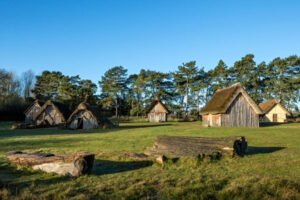In 2018, prior to the building of the Wilds Way development on what used to be known as the Millennium Field, Victory Housing commissioned an Archaeological Survey of the site.
They discovered physical evidence of a settlement dating back to the late Saxon period, which is approximately 850 to 1066 AD.
West Stow in Suffolk has a stunning recreation of Anglo-Saxon village buildings, possibly similar to those that would have been on our site almost two hundred years before William the Conqueror created the Domesday Book.
On January 6th 878 the Vikings, led by King Guthrum, launched a surprise attack on Alfred’s base at Chippenham. Alfred was forced to flee with just a small company of men onto the Somerset Levels, taking refuge in the home of a peasant woman. She asks him to watch her cakes (small loaves of bread) baking by the fire. But, perhaps distracted by his problems, he forgets and the cakes burn, and so is roundly scolded by the woman…
It’s quite possible that at the same this that was happening just a couple of hundred miles away, our ancestors were creating Knapton…
As part of the pre-build process, Victory Housing commissioned Suffolk Archaeology to carry out a risk assessment for an archaeological dig to ensure that they weren’t desecrating a site of historical significance. We have provided their Risk Assessment & Method Statement (RAMS) for Archaeological Evaluation, produced in April 2018, for you to read and/or download.
Their final report, published on the NNDC planning portal, covered an initial dig of seven trenches in May and June 2018 and uncovered archaeological features on site thought to be potentially significant, including a late Saxon to high medieval settlement.
“The site lies within an area of archaeological and historical interest and has the potential to reveal evidence of a range of periods. Prehistoric activity includes flint scatters recovered during metal detectorist surveys and crop-marks identified from aerial photography.”
And the report’s conclusion stated:
“Archaeological remains across the eastern half of the site, within the area of trenches two to six define a truncated late Saxon and early medieval settlement phase with evidence of pits, postholes and ditches.”
A spokeswoman from Flagship Group, which owns Victory Housing, said that the first dig informed the scoping report by Suffolk Archaeology which was approved by Norfolk County Council and highlighted the areas of interest for the full, second dig. These works were undertaken by Archaeological Solutions, and were completed in mid-March.


